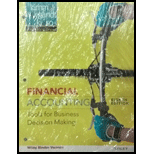
(a)
Formula of working capital:
To compute: (a) Working capital.
(a)
Explanation of Solution
Compute working capital of Corporation T, if current assets are $17,488,000,000 and current liabilities are $10,512,000,000.
Compute working capital of Corporation W, if current assets are $48,949,000,000 and current liabilities are $55,390,000,000.
(b)
Formula of current ratio:
To compute: (b) Current ratio.
(b)
Explanation of Solution
Compute current ratio of Corporation T, if current assets are $17,488,000,000 and current liabilities are $10,512,000,000.
Compute current ratio of Corporation W, if current assets are $48,949,000,000 and current liabilities are $55,390,000,000.
(c)
Debt to assets ratio: This financial ratio evaluates the ability of a company to pay off long-term debt obligations owed to creditors. This ratio assesses the solvency of a company.
Formula of debt to assets ratio:
To compute: (c) Debt to assets ratio.
(c)
Explanation of Solution
Compute debt to assets ratio of Corporation T, if total assets are $44,106,000,000, current liabilities are $10,512,000,000, and long-term liabilities are $19,882,000,000.
Compute debt to assets ratio of Corporation W, if total assets are $163,429,000,000, current liabilities are $55,390,000,000, and long-term liabilities are $42,754,000,000.
(d)
Formula of free cash flow:
To compute: (d) Free cash flow.
(d)
Explanation of Solution
Compute free
Compute free cash flow of Corporation W, if net cash provided by operating activities is $23,147,000,000, capital expenditures are $11,499,000,000, and dividends paid are $3,746,000,000.
(e)
Earnings per share (EPS): The amount of net income available to each shareholder per common share outstanding is referred to as earnings per share (EPS).
Formula of EPS:
To compute: (e) EPS of Corporation T and Corporation W for 2017.
(e)
Explanation of Solution
Compute EPS of Corporation T, if net income is $2,214,000,000, preferred dividends are $0, and weighted common shares outstanding are 774,000,000 shares.
Compute EPS of Corporation W, if net income is $13,400,000,000, preferred dividends are $0, and weighted common shares outstanding are 3,951,000,000 shares.
(f)
Working capital: The measure which evaluates the ability of a company to pay off the short-term debt obligations, by computing the excess of current assets over current liabilities is referred to as working capital.
Formula of working capital:
To analyze: (f) the liquidity and solvency position of two companies based on the computed ratios
Explanation of Solution
Analysis:
- Working capital of Corporation T is $6,976,000 and current ratio is 1.66:1. Working capital of Corporation W is $(6,441,000,000) and current ratio is 0.88:1. Based on these ratios, it can be inferred that the Corporation T is more liquid than Corporation W.
- Debt to assets ratio of Corporation T is 68.9% and free cash flow is $418,000,000. Debt to assets ratio of Corporation W is 60.1% and free cash flow is $7,902,000,000. Based on these two ratios, it can be inferred that the Corporation W is more solvent than Corporation T
Want to see more full solutions like this?
Chapter 2 Solutions
Bundle: Financial Accounting: Tools for Business Decision Making 8e Binder Ready Version + WileyPLUS Registration Code
- Please need answer the general accounting question not use aiarrow_forwardGroot Co. (GC) sells $1,200,000 of 6-year, 10% bonds at par plus accrued interest. The bonds are dated January 1, 2026 but due to market conditions are not issued until May 1, 2026. Interest is payable on June 30 and December 31 each year. The market rate of interest at time of issue is the same as the stated rate. Required The issuance of the bonds on May 1, 2026. Assume that GC has adopted a policy of crediting accrued interest payable for the accrued interest on the date of sale. Payment of interest on June 30, 2026. Payment of interest on December 31, 2026.arrow_forward1. Define working capital and explain its importance in financial health and liquidity management. 2. Assess how the matching concept and accrual basis affect the reporting of current assets and liabilities. 3. Using a hypothetical balance sheet (you may create one), identify at least 5 current assets and 5 current liabilities and analyze how changes in these elements affect liquidity ratios. 4. Recommend at least two strategies VinGrenDom Ltd. can implement to optimize working capital.arrow_forward
- Theron Interiors manufactures handcrafted cabinetry and uses a process costing system. During the month of October, the company started Production on 720 units and completed 590 units. The remaining 120 units were 60% complete in terms of materials and 40% complete in terms of labor and overhead. The total cost incurred during the month was $45,000 for materials and $31,200 for labor and overhead. Using the weighted-average method, what is the equivalent unit cost for materials and conversion costs (labor and overhead)?arrow_forwardGeneral Accountingarrow_forwardKamala Khan has to decide between the following two options: Take out a student loan of $70,000 and study accounting full time for the next three years. The interest on the loan is 4% per year payable annually. The principle is to be paid in full after ten years. Study part time and work part time to earn $15,000 per year for the following six years. Once Kamala graduates, she estimates that she will earn $30,000 for the first three years and $40,000 the next four years. Kamala's banker says the market interest for a ten-year horizon is 6%. Required Calculate NPV of the ten-year cash flows of the two options. For simplification assume that all cash flows happen at year-end. Based on the NPV which of the two options is better for Kamala?arrow_forward
 Financial Accounting: The Impact on Decision Make...AccountingISBN:9781305654174Author:Gary A. Porter, Curtis L. NortonPublisher:Cengage Learning
Financial Accounting: The Impact on Decision Make...AccountingISBN:9781305654174Author:Gary A. Porter, Curtis L. NortonPublisher:Cengage Learning
